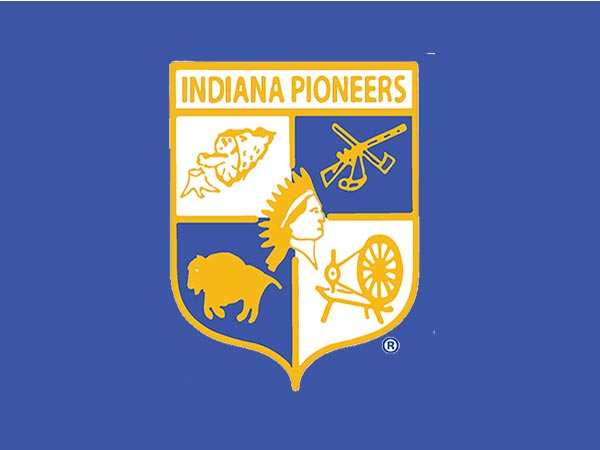State Parks and Bicentennial Heritage
Wednesday and Thursday, September 16-17, 2015
By Nelson Price
To kick off a series of trips celebrating Indiana’s upcoming Bicentennial in 2016 and the Centennial of the founding of the Society of Indiana Pioneers, the Fall Pilgrimage focused on Indiana’s glorious state parks. A lasting impact of the Centennial in 1916 was the creation of the state park system, so the two-day, overnight pilgrimage included two parks in southern Indiana among the destinations.
About 25 travelers participated in the pilgrimage on Sept. 16-17, a Wednesday and Thursday, with sunny, ideal weather on both days.
The first destination was Bloomington’s magnificent Monroe County Courthouse, built in 1908 and spared from demolition during the 1980s. The courthouse is surrounded by memorials and sculptures depicting the famous Four Freedoms and others dedicated to Hoosiers lost in the Civil War, World Wars, Korea, and Vietnam. A Peace Memorial created in the late 1970s is also on the site.
Inside the courthouse, a docent-led tour featured insights about the octagonal dome. During the restoration work, historic murals were discovered; the murals symbolize education (because of the presence of Indiana University); the limestone industry, agriculture and justice itself. Stained glass in the courthouse was created by the Opalescent Glass Company of Kokomo, which is still in business after more than 100 years.
The next stop was Bloomington’s historic Carnegie Library, which closed in 1970. Today, the building houses the Monroe County Historical Society. An impressive county history museum includes exhibits about notables such as composer Hoagy Carmichael (displays feature one of his blazers as well as sheet music to “Stardust”) and engineer/inventor Sarkes Tarzian.
At the Monroe County Historical Society, the Pioneers enjoyed a buffet luncheon. The speaker was esteemed historian/author James Madison, who shared insights about 200 years of the state’s history. A motor coach tour of the Maple Grove Road Historic District northwest of Bloomington followed the luncheon. Some farmhouses in the state’s first rural historic district date to the 1820s; several have limestone fences hand-built by Irish immigrants.
In Bloomington, the Pioneers toured the Lilly Library at Indiana University, which has 400,000 rare books and manuscripts. For the group’s visit, the library had a special exhibit of Indiana books written prior to 1840 or about the Pioneer era.
Other exhibits included artifacts related to James Whitcomb Riley, the “Hoosier Poet,” and even advertisements for products he endorsed in the late 19th and early 20th centuries. Joel Silver, executive director of the Lilly Library, talked to the Pioneers about the library’s evolution. The collection was begun thanks to donations by philanthropist J.K. Lilly, whose personal library had thousands of books, including many first editions of Riley’s poetry.
From Bloomington, the Pioneers traveled to Spring Mill State Park in Lawrence County. A catered, 1840s-style dinner was served in the park’s grist mill, built in 1817. During dinner, the grist mill’s operator explained the history of Spring Mill, which was a thriving village in the early 1800s. For several reasons – including the coming of railroads, which bypassed Spring Mill – by the 1890s, the village had been abandoned.
Structures at the state park are a mix of original, historic buildings, including cabins that have been restored; re-creations, and historic structures built elsewhere during the pioneer era and moved to Spring Mill. The Pioneers enjoyed self-guided tours of the cabins, several of which have oil paintings and historic quilts. The group also enjoyed the landscaping and gardens at the state park.
Overnight accommodations were at the Spring Mill State Park Inn. In the morning, a Spring Mill naturalist presented about the state park’s creation.
The next destination in Lawrence County was unforgettable: Blue Springs Cavern, which has the second or third-longest cave in the state. Pioneers descended into boats for intriguing tours of the dark, underground cave system known for its captivating features.
The next destination was Indiana’s first state park created in 1916, McCormick’s Creek in Owen County. The park’s naturalist presented a history of McCormick’s Creek that particularly focused on the work of the Civilian Conservation Corps during the Great Depression. His talk – accompanied by visuals – was in a structure built by the CCC, which undertook much of the development of the state parks.
After traveling back to Bloomington, the Pioneers toured the Wylie House Museum. It’s a historic home built in 1835 for I.U.’s first president, Andrew Wylie, and his family. The Federal and Georgian-style house remains one of the few pre-1840 structures in Bloomington. In addition to being a house museum, it is now the setting for musical concerts, lectures, and cultural events.
The Pioneers stopped at Oliver Winery in Monroe County on the return trip to Indianapolis. The group enjoyed a wine tasting and savored a wonderful, two-day experience.
